Analyzing Gillick Competence in Pediatric Nursing: Amira Case Study
VerifiedAdded on 2022/08/23
|9
|2362
|28
Presentation
AI Summary
This presentation analyzes the Gillick competence, a legal and ethical framework for assessing a child's ability to consent to medical treatment, using the case study of Amira, a 13-year-old refugee refusing treatment for acute appendicitis. The presentation explores the principles of child-centered and family-centered care within pediatric nursing, contrasting these approaches concerning the Gillick competence. It examines age-appropriate needs, policy inclusiveness, and philosophical influences, including deontology and professional standards, to provide recommendations for handling similar cases. The discussion covers the maturity, intelligence, and health literacy of the child, as well as the impact of cultural influences and family preferences. The presentation emphasizes the need for nurses to balance respecting a child's autonomy with ethical and legal responsibilities, considering family involvement and cultural sensitivity. The conclusion reiterates the importance of evidence-based decision-making in pediatric nursing, advocating for adherence to professional codes and philosophical models while respecting Amira's preferences.

Running head: THE GILLICK COMPETENCE: CASE STUDY OF AMIRA: ABSTRACT
THE GILLICK COMPETENCE: CASE STUDY OF AMIRA: NOTES FOR PRESENTATION
Name of the Student:
Name of the University:
Author note:
THE GILLICK COMPETENCE: CASE STUDY OF AMIRA: NOTES FOR PRESENTATION
Name of the Student:
Name of the University:
Author note:
Paraphrase This Document
Need a fresh take? Get an instant paraphrase of this document with our AI Paraphraser
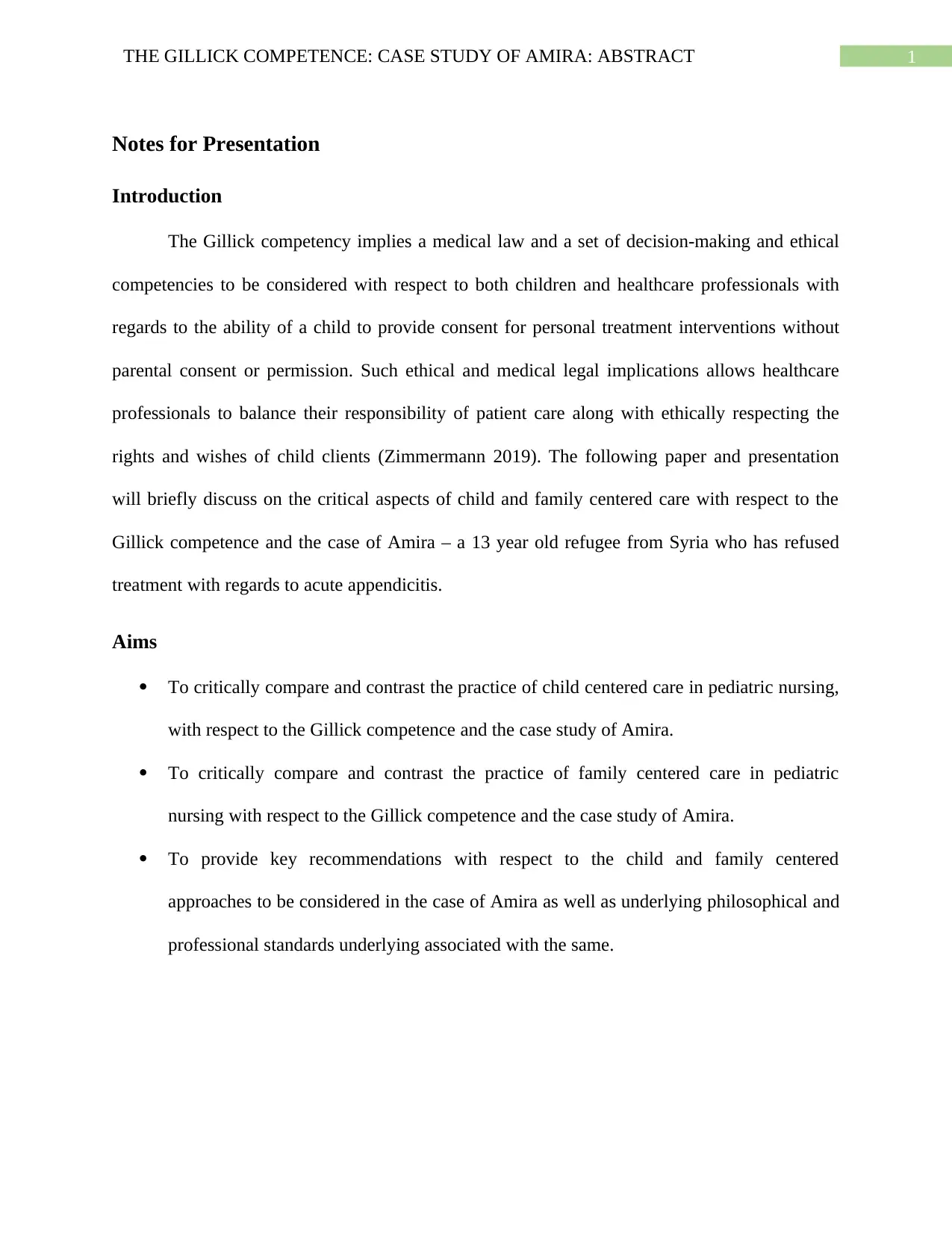
1THE GILLICK COMPETENCE: CASE STUDY OF AMIRA: ABSTRACT
Notes for Presentation
Introduction
The Gillick competency implies a medical law and a set of decision-making and ethical
competencies to be considered with respect to both children and healthcare professionals with
regards to the ability of a child to provide consent for personal treatment interventions without
parental consent or permission. Such ethical and medical legal implications allows healthcare
professionals to balance their responsibility of patient care along with ethically respecting the
rights and wishes of child clients (Zimmermann 2019). The following paper and presentation
will briefly discuss on the critical aspects of child and family centered care with respect to the
Gillick competence and the case of Amira – a 13 year old refugee from Syria who has refused
treatment with regards to acute appendicitis.
Aims
To critically compare and contrast the practice of child centered care in pediatric nursing,
with respect to the Gillick competence and the case study of Amira.
To critically compare and contrast the practice of family centered care in pediatric
nursing with respect to the Gillick competence and the case study of Amira.
To provide key recommendations with respect to the child and family centered
approaches to be considered in the case of Amira as well as underlying philosophical and
professional standards underlying associated with the same.
Notes for Presentation
Introduction
The Gillick competency implies a medical law and a set of decision-making and ethical
competencies to be considered with respect to both children and healthcare professionals with
regards to the ability of a child to provide consent for personal treatment interventions without
parental consent or permission. Such ethical and medical legal implications allows healthcare
professionals to balance their responsibility of patient care along with ethically respecting the
rights and wishes of child clients (Zimmermann 2019). The following paper and presentation
will briefly discuss on the critical aspects of child and family centered care with respect to the
Gillick competence and the case of Amira – a 13 year old refugee from Syria who has refused
treatment with regards to acute appendicitis.
Aims
To critically compare and contrast the practice of child centered care in pediatric nursing,
with respect to the Gillick competence and the case study of Amira.
To critically compare and contrast the practice of family centered care in pediatric
nursing with respect to the Gillick competence and the case study of Amira.
To provide key recommendations with respect to the child and family centered
approaches to be considered in the case of Amira as well as underlying philosophical and
professional standards underlying associated with the same.

2THE GILLICK COMPETENCE: CASE STUDY OF AMIRA: ABSTRACT
Discussion
Age Appropriate Needs
The Gillick competency is mentioned as a part of legal implications and provisions
associated with treatment interventions and children consent to treatment, only in New South
Wales (NSW) and South Australia (SA), taking reference to the 1986 judgment of Gillick v West
Norfolk and Wisbech Area Health Authority (Young 2019). With respect to the same, as per this
medical law of competency, a child who is under the age of 16 years has the legal right to
consent refuse any form of medical treatment or immunization (Griffith 2016). However, in
addition to merely age, a child is considered to be Gillick competent, as per the following criteria
(Griffith 2016).
The maturity of a child
The intelligence of a child
The child’s ability to understand the risks and benefits of treatment as well as his or her
decisions and views concerning long term implications on family and personal life
aspects like education.
The ability and experiences of the child with respect the role of family, peer pressures
and his or her opinions in the clinical decision making process (Griffith 2016).
Thus, from the above, one of the major strengths of the Gillick competence is its ability
to not just consider the age of the child, but to also consider broader aspects of the child’s
understanding with regards to the consequences of personal decisions and treatment on his or her
own as well the life of the family (Harling 2017). However, in criticism, there is no mention on
the standards and measurements to be considered with respect to understanding the level of
maturity and intelligence in a child. While an extensive range of standards and tests for
Discussion
Age Appropriate Needs
The Gillick competency is mentioned as a part of legal implications and provisions
associated with treatment interventions and children consent to treatment, only in New South
Wales (NSW) and South Australia (SA), taking reference to the 1986 judgment of Gillick v West
Norfolk and Wisbech Area Health Authority (Young 2019). With respect to the same, as per this
medical law of competency, a child who is under the age of 16 years has the legal right to
consent refuse any form of medical treatment or immunization (Griffith 2016). However, in
addition to merely age, a child is considered to be Gillick competent, as per the following criteria
(Griffith 2016).
The maturity of a child
The intelligence of a child
The child’s ability to understand the risks and benefits of treatment as well as his or her
decisions and views concerning long term implications on family and personal life
aspects like education.
The ability and experiences of the child with respect the role of family, peer pressures
and his or her opinions in the clinical decision making process (Griffith 2016).
Thus, from the above, one of the major strengths of the Gillick competence is its ability
to not just consider the age of the child, but to also consider broader aspects of the child’s
understanding with regards to the consequences of personal decisions and treatment on his or her
own as well the life of the family (Harling 2017). However, in criticism, there is no mention on
the standards and measurements to be considered with respect to understanding the level of
maturity and intelligence in a child. While an extensive range of standards and tests for
⊘ This is a preview!⊘
Do you want full access?
Subscribe today to unlock all pages.

Trusted by 1+ million students worldwide
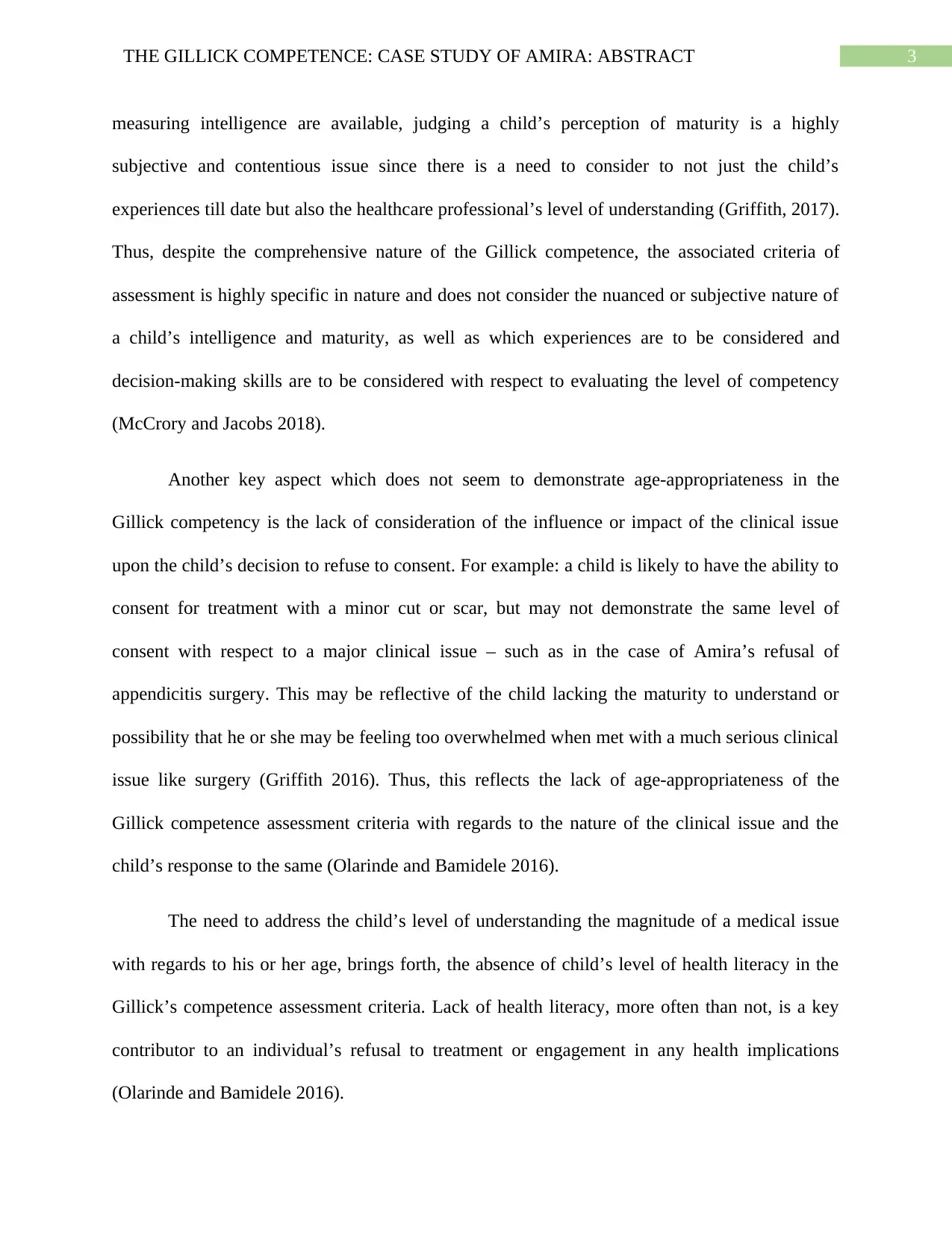
3THE GILLICK COMPETENCE: CASE STUDY OF AMIRA: ABSTRACT
measuring intelligence are available, judging a child’s perception of maturity is a highly
subjective and contentious issue since there is a need to consider to not just the child’s
experiences till date but also the healthcare professional’s level of understanding (Griffith, 2017).
Thus, despite the comprehensive nature of the Gillick competence, the associated criteria of
assessment is highly specific in nature and does not consider the nuanced or subjective nature of
a child’s intelligence and maturity, as well as which experiences are to be considered and
decision-making skills are to be considered with respect to evaluating the level of competency
(McCrory and Jacobs 2018).
Another key aspect which does not seem to demonstrate age-appropriateness in the
Gillick competency is the lack of consideration of the influence or impact of the clinical issue
upon the child’s decision to refuse to consent. For example: a child is likely to have the ability to
consent for treatment with a minor cut or scar, but may not demonstrate the same level of
consent with respect to a major clinical issue – such as in the case of Amira’s refusal of
appendicitis surgery. This may be reflective of the child lacking the maturity to understand or
possibility that he or she may be feeling too overwhelmed when met with a much serious clinical
issue like surgery (Griffith 2016). Thus, this reflects the lack of age-appropriateness of the
Gillick competence assessment criteria with regards to the nature of the clinical issue and the
child’s response to the same (Olarinde and Bamidele 2016).
The need to address the child’s level of understanding the magnitude of a medical issue
with regards to his or her age, brings forth, the absence of child’s level of health literacy in the
Gillick’s competence assessment criteria. Lack of health literacy, more often than not, is a key
contributor to an individual’s refusal to treatment or engagement in any health implications
(Olarinde and Bamidele 2016).
measuring intelligence are available, judging a child’s perception of maturity is a highly
subjective and contentious issue since there is a need to consider to not just the child’s
experiences till date but also the healthcare professional’s level of understanding (Griffith, 2017).
Thus, despite the comprehensive nature of the Gillick competence, the associated criteria of
assessment is highly specific in nature and does not consider the nuanced or subjective nature of
a child’s intelligence and maturity, as well as which experiences are to be considered and
decision-making skills are to be considered with respect to evaluating the level of competency
(McCrory and Jacobs 2018).
Another key aspect which does not seem to demonstrate age-appropriateness in the
Gillick competency is the lack of consideration of the influence or impact of the clinical issue
upon the child’s decision to refuse to consent. For example: a child is likely to have the ability to
consent for treatment with a minor cut or scar, but may not demonstrate the same level of
consent with respect to a major clinical issue – such as in the case of Amira’s refusal of
appendicitis surgery. This may be reflective of the child lacking the maturity to understand or
possibility that he or she may be feeling too overwhelmed when met with a much serious clinical
issue like surgery (Griffith 2016). Thus, this reflects the lack of age-appropriateness of the
Gillick competence assessment criteria with regards to the nature of the clinical issue and the
child’s response to the same (Olarinde and Bamidele 2016).
The need to address the child’s level of understanding the magnitude of a medical issue
with regards to his or her age, brings forth, the absence of child’s level of health literacy in the
Gillick’s competence assessment criteria. Lack of health literacy, more often than not, is a key
contributor to an individual’s refusal to treatment or engagement in any health implications
(Olarinde and Bamidele 2016).
Paraphrase This Document
Need a fresh take? Get an instant paraphrase of this document with our AI Paraphraser
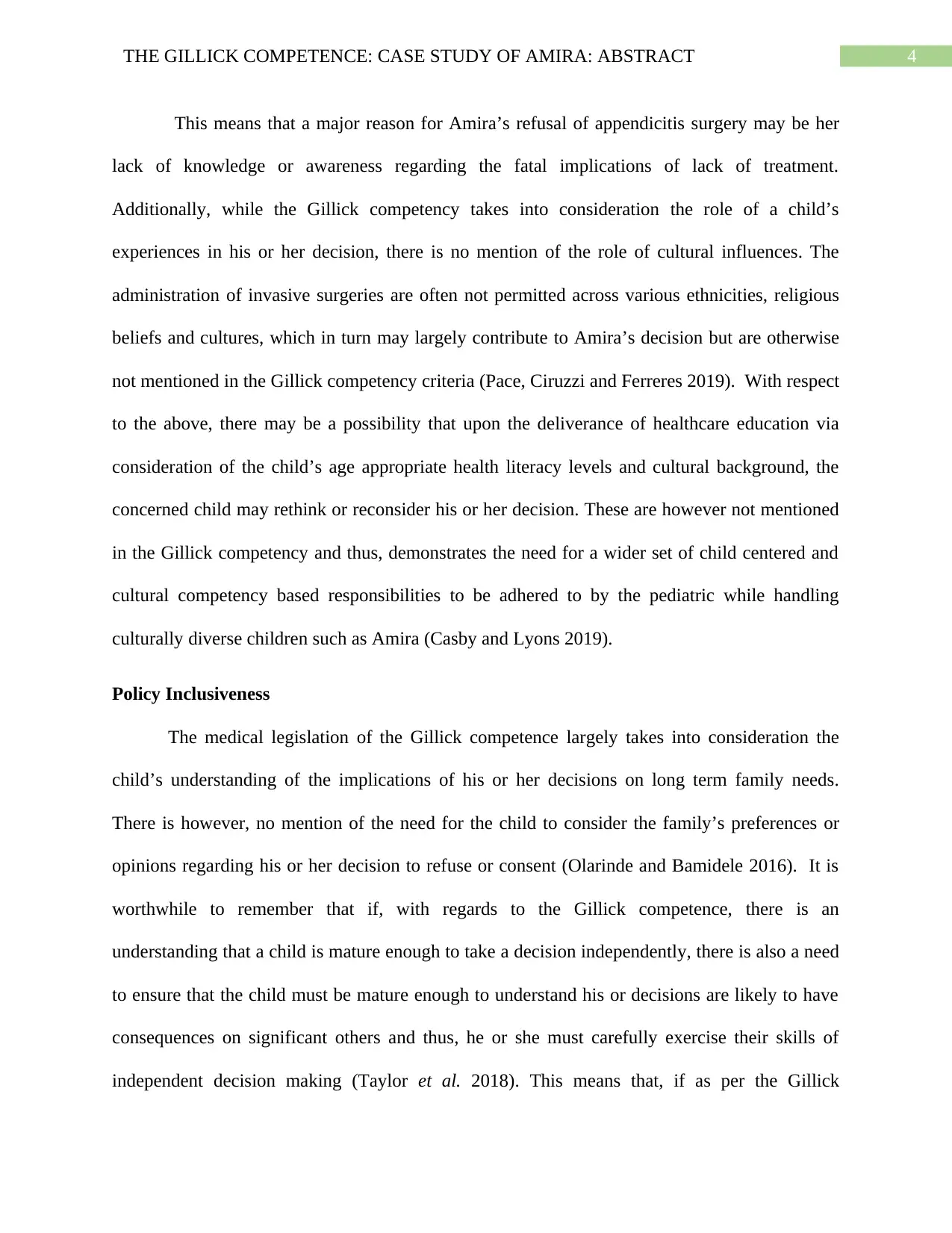
4THE GILLICK COMPETENCE: CASE STUDY OF AMIRA: ABSTRACT
This means that a major reason for Amira’s refusal of appendicitis surgery may be her
lack of knowledge or awareness regarding the fatal implications of lack of treatment.
Additionally, while the Gillick competency takes into consideration the role of a child’s
experiences in his or her decision, there is no mention of the role of cultural influences. The
administration of invasive surgeries are often not permitted across various ethnicities, religious
beliefs and cultures, which in turn may largely contribute to Amira’s decision but are otherwise
not mentioned in the Gillick competency criteria (Pace, Ciruzzi and Ferreres 2019). With respect
to the above, there may be a possibility that upon the deliverance of healthcare education via
consideration of the child’s age appropriate health literacy levels and cultural background, the
concerned child may rethink or reconsider his or her decision. These are however not mentioned
in the Gillick competency and thus, demonstrates the need for a wider set of child centered and
cultural competency based responsibilities to be adhered to by the pediatric while handling
culturally diverse children such as Amira (Casby and Lyons 2019).
Policy Inclusiveness
The medical legislation of the Gillick competence largely takes into consideration the
child’s understanding of the implications of his or her decisions on long term family needs.
There is however, no mention of the need for the child to consider the family’s preferences or
opinions regarding his or her decision to refuse or consent (Olarinde and Bamidele 2016). It is
worthwhile to remember that if, with regards to the Gillick competence, there is an
understanding that a child is mature enough to take a decision independently, there is also a need
to ensure that the child must be mature enough to understand his or decisions are likely to have
consequences on significant others and thus, he or she must carefully exercise their skills of
independent decision making (Taylor et al. 2018). This means that, if as per the Gillick
This means that a major reason for Amira’s refusal of appendicitis surgery may be her
lack of knowledge or awareness regarding the fatal implications of lack of treatment.
Additionally, while the Gillick competency takes into consideration the role of a child’s
experiences in his or her decision, there is no mention of the role of cultural influences. The
administration of invasive surgeries are often not permitted across various ethnicities, religious
beliefs and cultures, which in turn may largely contribute to Amira’s decision but are otherwise
not mentioned in the Gillick competency criteria (Pace, Ciruzzi and Ferreres 2019). With respect
to the above, there may be a possibility that upon the deliverance of healthcare education via
consideration of the child’s age appropriate health literacy levels and cultural background, the
concerned child may rethink or reconsider his or her decision. These are however not mentioned
in the Gillick competency and thus, demonstrates the need for a wider set of child centered and
cultural competency based responsibilities to be adhered to by the pediatric while handling
culturally diverse children such as Amira (Casby and Lyons 2019).
Policy Inclusiveness
The medical legislation of the Gillick competence largely takes into consideration the
child’s understanding of the implications of his or her decisions on long term family needs.
There is however, no mention of the need for the child to consider the family’s preferences or
opinions regarding his or her decision to refuse or consent (Olarinde and Bamidele 2016). It is
worthwhile to remember that if, with regards to the Gillick competence, there is an
understanding that a child is mature enough to take a decision independently, there is also a need
to ensure that the child must be mature enough to understand his or decisions are likely to have
consequences on significant others and thus, he or she must carefully exercise their skills of
independent decision making (Taylor et al. 2018). This means that, if as per the Gillick
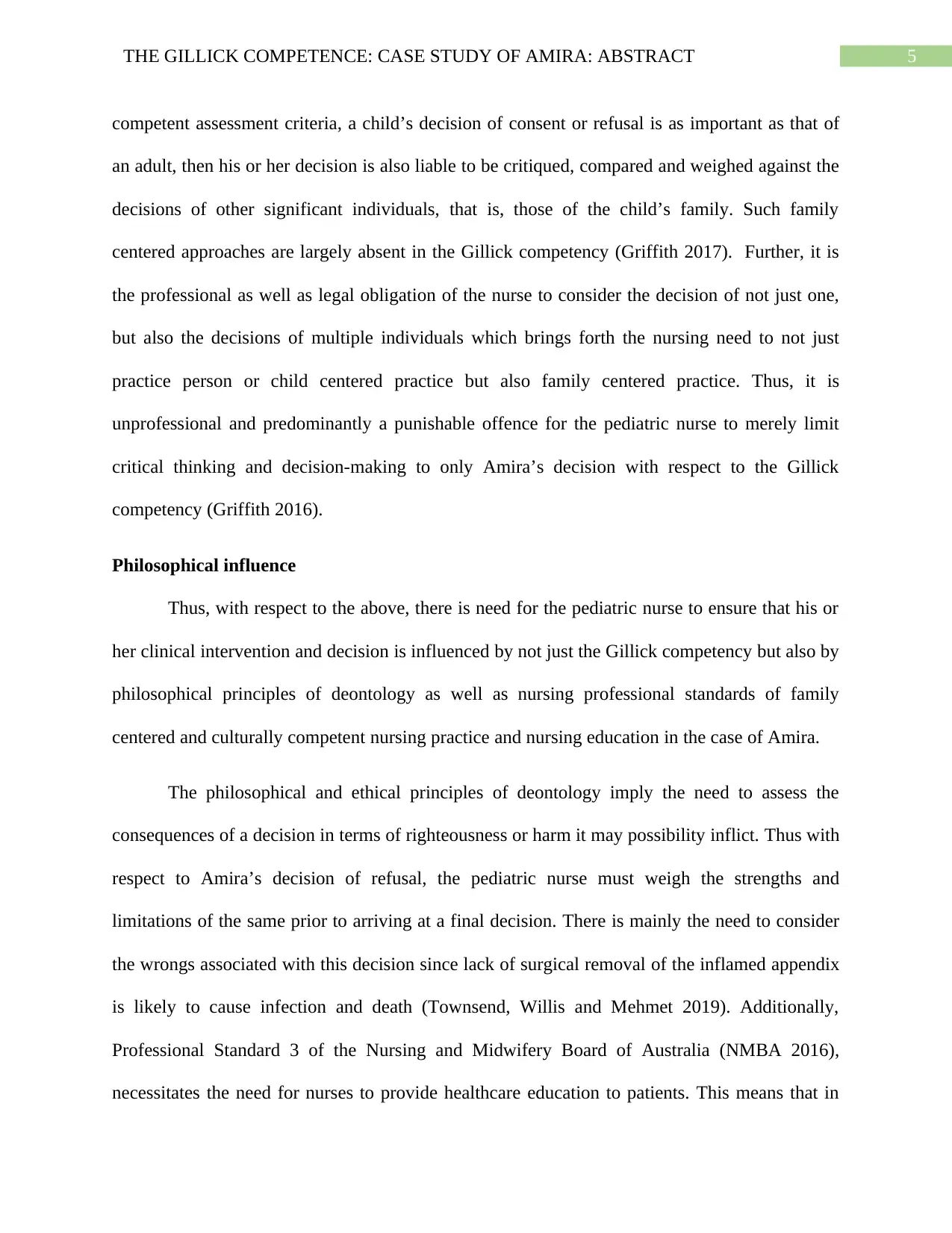
5THE GILLICK COMPETENCE: CASE STUDY OF AMIRA: ABSTRACT
competent assessment criteria, a child’s decision of consent or refusal is as important as that of
an adult, then his or her decision is also liable to be critiqued, compared and weighed against the
decisions of other significant individuals, that is, those of the child’s family. Such family
centered approaches are largely absent in the Gillick competency (Griffith 2017). Further, it is
the professional as well as legal obligation of the nurse to consider the decision of not just one,
but also the decisions of multiple individuals which brings forth the nursing need to not just
practice person or child centered practice but also family centered practice. Thus, it is
unprofessional and predominantly a punishable offence for the pediatric nurse to merely limit
critical thinking and decision-making to only Amira’s decision with respect to the Gillick
competency (Griffith 2016).
Philosophical influence
Thus, with respect to the above, there is need for the pediatric nurse to ensure that his or
her clinical intervention and decision is influenced by not just the Gillick competency but also by
philosophical principles of deontology as well as nursing professional standards of family
centered and culturally competent nursing practice and nursing education in the case of Amira.
The philosophical and ethical principles of deontology imply the need to assess the
consequences of a decision in terms of righteousness or harm it may possibility inflict. Thus with
respect to Amira’s decision of refusal, the pediatric nurse must weigh the strengths and
limitations of the same prior to arriving at a final decision. There is mainly the need to consider
the wrongs associated with this decision since lack of surgical removal of the inflamed appendix
is likely to cause infection and death (Townsend, Willis and Mehmet 2019). Additionally,
Professional Standard 3 of the Nursing and Midwifery Board of Australia (NMBA 2016),
necessitates the need for nurses to provide healthcare education to patients. This means that in
competent assessment criteria, a child’s decision of consent or refusal is as important as that of
an adult, then his or her decision is also liable to be critiqued, compared and weighed against the
decisions of other significant individuals, that is, those of the child’s family. Such family
centered approaches are largely absent in the Gillick competency (Griffith 2017). Further, it is
the professional as well as legal obligation of the nurse to consider the decision of not just one,
but also the decisions of multiple individuals which brings forth the nursing need to not just
practice person or child centered practice but also family centered practice. Thus, it is
unprofessional and predominantly a punishable offence for the pediatric nurse to merely limit
critical thinking and decision-making to only Amira’s decision with respect to the Gillick
competency (Griffith 2016).
Philosophical influence
Thus, with respect to the above, there is need for the pediatric nurse to ensure that his or
her clinical intervention and decision is influenced by not just the Gillick competency but also by
philosophical principles of deontology as well as nursing professional standards of family
centered and culturally competent nursing practice and nursing education in the case of Amira.
The philosophical and ethical principles of deontology imply the need to assess the
consequences of a decision in terms of righteousness or harm it may possibility inflict. Thus with
respect to Amira’s decision of refusal, the pediatric nurse must weigh the strengths and
limitations of the same prior to arriving at a final decision. There is mainly the need to consider
the wrongs associated with this decision since lack of surgical removal of the inflamed appendix
is likely to cause infection and death (Townsend, Willis and Mehmet 2019). Additionally,
Professional Standard 3 of the Nursing and Midwifery Board of Australia (NMBA 2016),
necessitates the need for nurses to provide healthcare education to patients. This means that in
⊘ This is a preview!⊘
Do you want full access?
Subscribe today to unlock all pages.

Trusted by 1+ million students worldwide
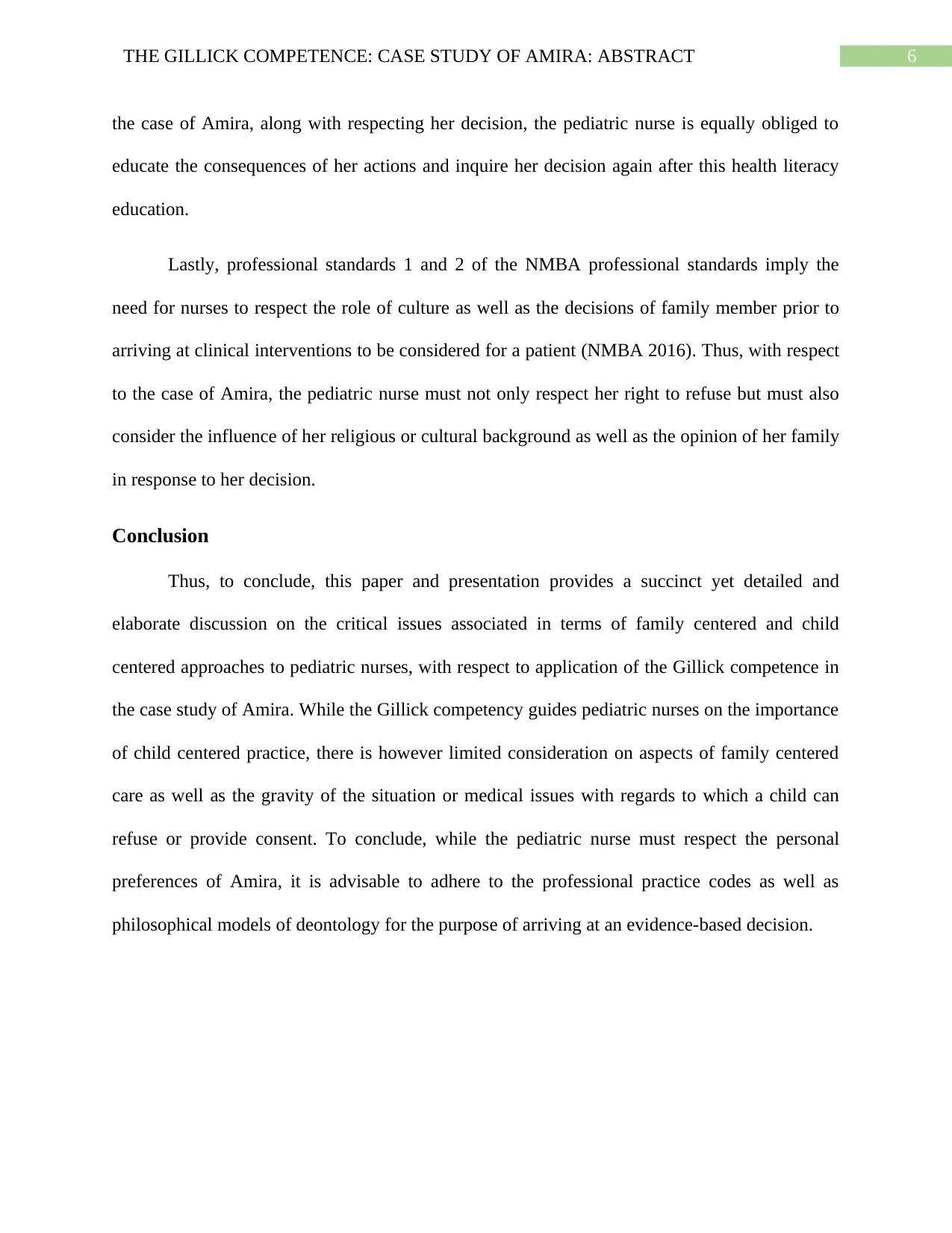
6THE GILLICK COMPETENCE: CASE STUDY OF AMIRA: ABSTRACT
the case of Amira, along with respecting her decision, the pediatric nurse is equally obliged to
educate the consequences of her actions and inquire her decision again after this health literacy
education.
Lastly, professional standards 1 and 2 of the NMBA professional standards imply the
need for nurses to respect the role of culture as well as the decisions of family member prior to
arriving at clinical interventions to be considered for a patient (NMBA 2016). Thus, with respect
to the case of Amira, the pediatric nurse must not only respect her right to refuse but must also
consider the influence of her religious or cultural background as well as the opinion of her family
in response to her decision.
Conclusion
Thus, to conclude, this paper and presentation provides a succinct yet detailed and
elaborate discussion on the critical issues associated in terms of family centered and child
centered approaches to pediatric nurses, with respect to application of the Gillick competence in
the case study of Amira. While the Gillick competency guides pediatric nurses on the importance
of child centered practice, there is however limited consideration on aspects of family centered
care as well as the gravity of the situation or medical issues with regards to which a child can
refuse or provide consent. To conclude, while the pediatric nurse must respect the personal
preferences of Amira, it is advisable to adhere to the professional practice codes as well as
philosophical models of deontology for the purpose of arriving at an evidence-based decision.
the case of Amira, along with respecting her decision, the pediatric nurse is equally obliged to
educate the consequences of her actions and inquire her decision again after this health literacy
education.
Lastly, professional standards 1 and 2 of the NMBA professional standards imply the
need for nurses to respect the role of culture as well as the decisions of family member prior to
arriving at clinical interventions to be considered for a patient (NMBA 2016). Thus, with respect
to the case of Amira, the pediatric nurse must not only respect her right to refuse but must also
consider the influence of her religious or cultural background as well as the opinion of her family
in response to her decision.
Conclusion
Thus, to conclude, this paper and presentation provides a succinct yet detailed and
elaborate discussion on the critical issues associated in terms of family centered and child
centered approaches to pediatric nurses, with respect to application of the Gillick competence in
the case study of Amira. While the Gillick competency guides pediatric nurses on the importance
of child centered practice, there is however limited consideration on aspects of family centered
care as well as the gravity of the situation or medical issues with regards to which a child can
refuse or provide consent. To conclude, while the pediatric nurse must respect the personal
preferences of Amira, it is advisable to adhere to the professional practice codes as well as
philosophical models of deontology for the purpose of arriving at an evidence-based decision.
Paraphrase This Document
Need a fresh take? Get an instant paraphrase of this document with our AI Paraphraser
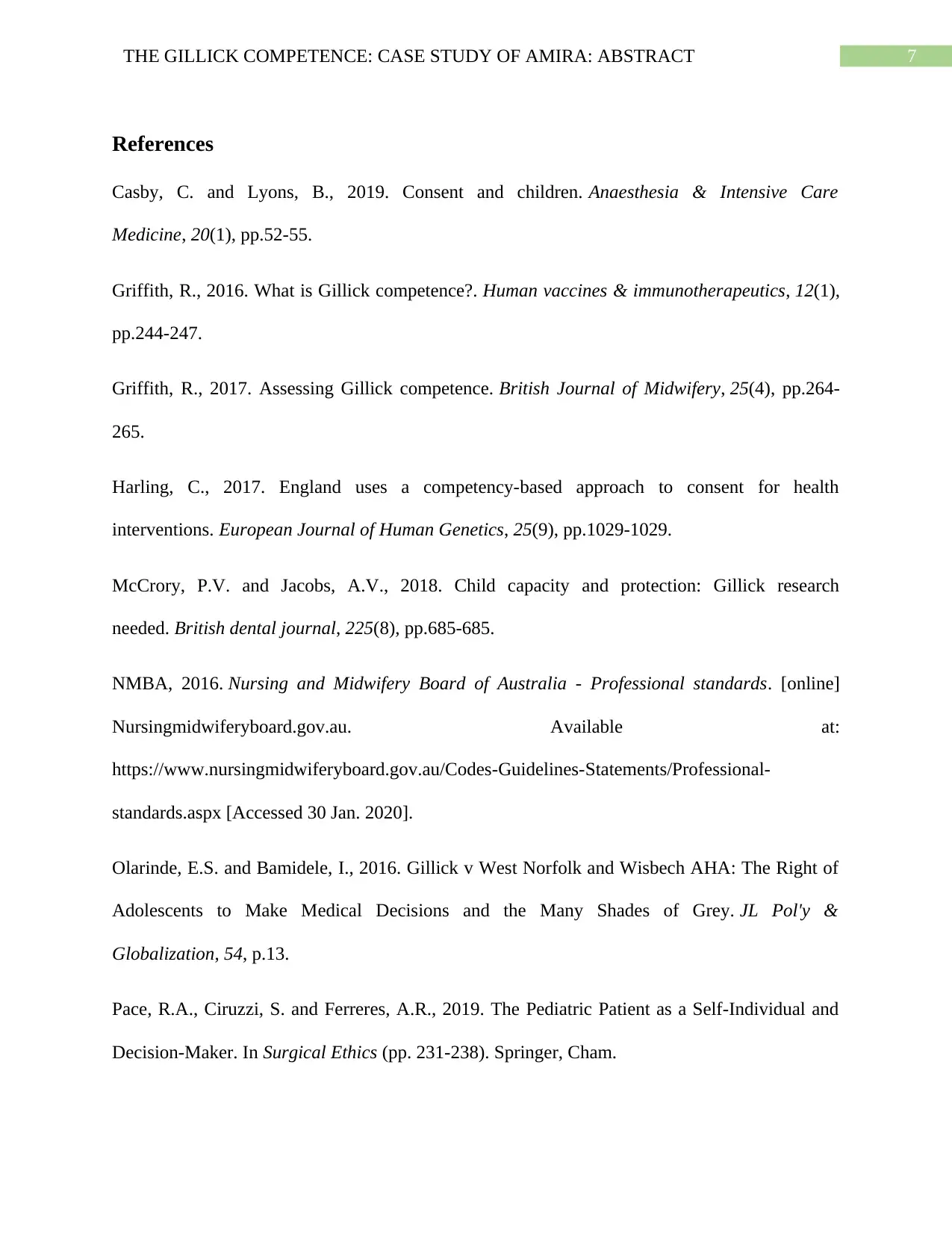
7THE GILLICK COMPETENCE: CASE STUDY OF AMIRA: ABSTRACT
References
Casby, C. and Lyons, B., 2019. Consent and children. Anaesthesia & Intensive Care
Medicine, 20(1), pp.52-55.
Griffith, R., 2016. What is Gillick competence?. Human vaccines & immunotherapeutics, 12(1),
pp.244-247.
Griffith, R., 2017. Assessing Gillick competence. British Journal of Midwifery, 25(4), pp.264-
265.
Harling, C., 2017. England uses a competency-based approach to consent for health
interventions. European Journal of Human Genetics, 25(9), pp.1029-1029.
McCrory, P.V. and Jacobs, A.V., 2018. Child capacity and protection: Gillick research
needed. British dental journal, 225(8), pp.685-685.
NMBA, 2016. Nursing and Midwifery Board of Australia - Professional standards. [online]
Nursingmidwiferyboard.gov.au. Available at:
https://www.nursingmidwiferyboard.gov.au/Codes-Guidelines-Statements/Professional-
standards.aspx [Accessed 30 Jan. 2020].
Olarinde, E.S. and Bamidele, I., 2016. Gillick v West Norfolk and Wisbech AHA: The Right of
Adolescents to Make Medical Decisions and the Many Shades of Grey. JL Pol'y &
Globalization, 54, p.13.
Pace, R.A., Ciruzzi, S. and Ferreres, A.R., 2019. The Pediatric Patient as a Self-Individual and
Decision-Maker. In Surgical Ethics (pp. 231-238). Springer, Cham.
References
Casby, C. and Lyons, B., 2019. Consent and children. Anaesthesia & Intensive Care
Medicine, 20(1), pp.52-55.
Griffith, R., 2016. What is Gillick competence?. Human vaccines & immunotherapeutics, 12(1),
pp.244-247.
Griffith, R., 2017. Assessing Gillick competence. British Journal of Midwifery, 25(4), pp.264-
265.
Harling, C., 2017. England uses a competency-based approach to consent for health
interventions. European Journal of Human Genetics, 25(9), pp.1029-1029.
McCrory, P.V. and Jacobs, A.V., 2018. Child capacity and protection: Gillick research
needed. British dental journal, 225(8), pp.685-685.
NMBA, 2016. Nursing and Midwifery Board of Australia - Professional standards. [online]
Nursingmidwiferyboard.gov.au. Available at:
https://www.nursingmidwiferyboard.gov.au/Codes-Guidelines-Statements/Professional-
standards.aspx [Accessed 30 Jan. 2020].
Olarinde, E.S. and Bamidele, I., 2016. Gillick v West Norfolk and Wisbech AHA: The Right of
Adolescents to Make Medical Decisions and the Many Shades of Grey. JL Pol'y &
Globalization, 54, p.13.
Pace, R.A., Ciruzzi, S. and Ferreres, A.R., 2019. The Pediatric Patient as a Self-Individual and
Decision-Maker. In Surgical Ethics (pp. 231-238). Springer, Cham.
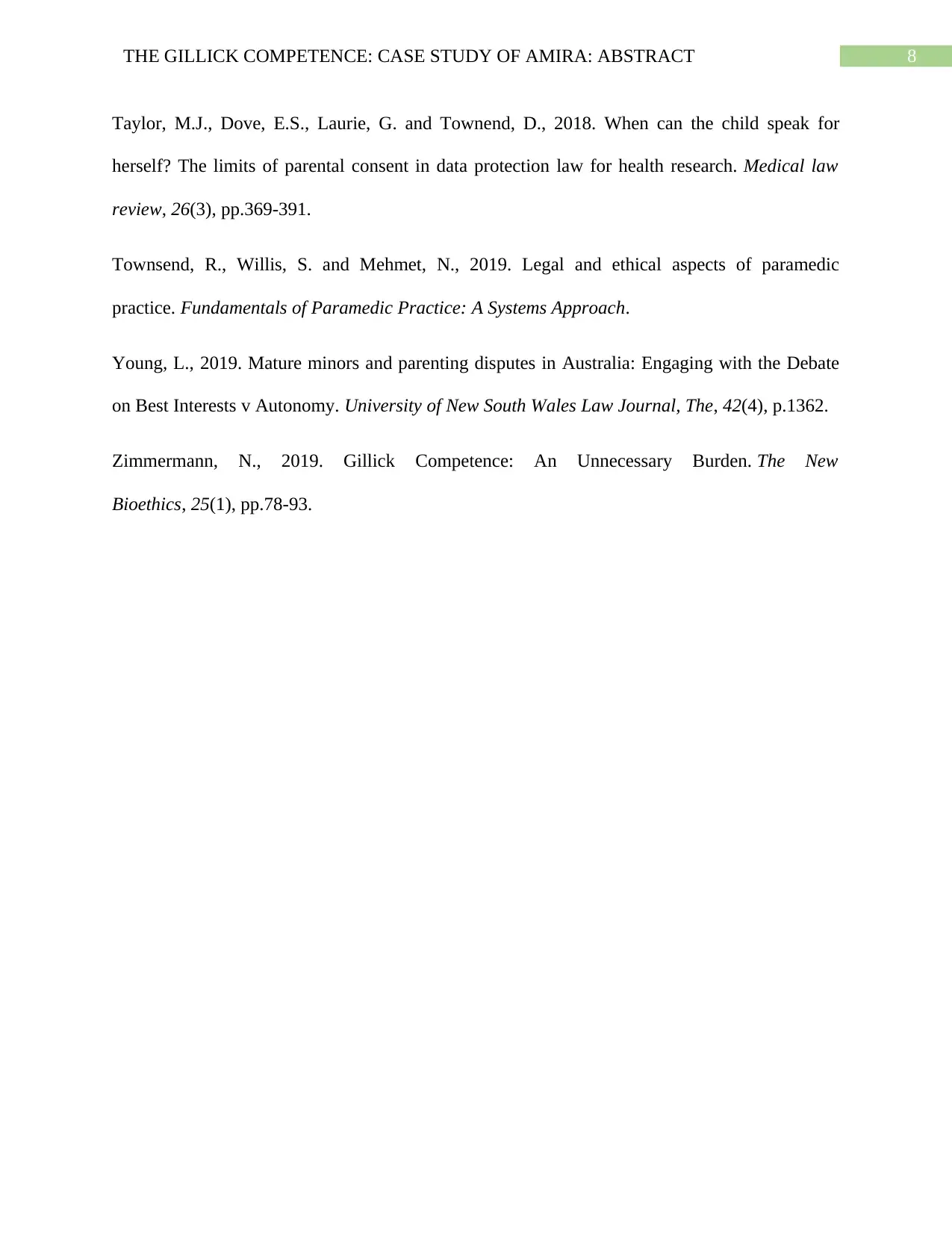
8THE GILLICK COMPETENCE: CASE STUDY OF AMIRA: ABSTRACT
Taylor, M.J., Dove, E.S., Laurie, G. and Townend, D., 2018. When can the child speak for
herself? The limits of parental consent in data protection law for health research. Medical law
review, 26(3), pp.369-391.
Townsend, R., Willis, S. and Mehmet, N., 2019. Legal and ethical aspects of paramedic
practice. Fundamentals of Paramedic Practice: A Systems Approach.
Young, L., 2019. Mature minors and parenting disputes in Australia: Engaging with the Debate
on Best Interests v Autonomy. University of New South Wales Law Journal, The, 42(4), p.1362.
Zimmermann, N., 2019. Gillick Competence: An Unnecessary Burden. The New
Bioethics, 25(1), pp.78-93.
Taylor, M.J., Dove, E.S., Laurie, G. and Townend, D., 2018. When can the child speak for
herself? The limits of parental consent in data protection law for health research. Medical law
review, 26(3), pp.369-391.
Townsend, R., Willis, S. and Mehmet, N., 2019. Legal and ethical aspects of paramedic
practice. Fundamentals of Paramedic Practice: A Systems Approach.
Young, L., 2019. Mature minors and parenting disputes in Australia: Engaging with the Debate
on Best Interests v Autonomy. University of New South Wales Law Journal, The, 42(4), p.1362.
Zimmermann, N., 2019. Gillick Competence: An Unnecessary Burden. The New
Bioethics, 25(1), pp.78-93.
⊘ This is a preview!⊘
Do you want full access?
Subscribe today to unlock all pages.

Trusted by 1+ million students worldwide
1 out of 9
Related Documents
Your All-in-One AI-Powered Toolkit for Academic Success.
+13062052269
info@desklib.com
Available 24*7 on WhatsApp / Email
![[object Object]](/_next/static/media/star-bottom.7253800d.svg)
Unlock your academic potential
Copyright © 2020–2026 A2Z Services. All Rights Reserved. Developed and managed by ZUCOL.





